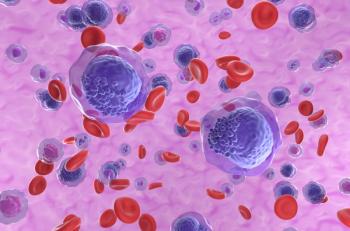
Matching Adjusted Indirect Comparison of Trial Data Indicate Survival Advantage with Brukinsa Over Calquence for CLL
Data from a pair of Phase III trials indicated a progression-free survival and complete response advantage in favor of Brukinsa in patients with relapsed or refractory chronic lymphocytic leukemia.
BeiGene’s Brukinsa (zanubrutinib) showed superiority to Calquence (acalabrutinib) in a matching adjusted indirect comparison (MAIC) evaluating the efficacy of these therapies in patients with relapsed or refractory (R/R) chronic lymphocytic leukemia (CLL).1 Data from a pair of Phase III trials—ALPINE and ASCEND—indicated a progression-free survival (PFS) and complete response advantage, with potentially improved overall survival (OS), in favor of Brukinsa.
“The CLL landscape is evolving rapidly, and this MAIC provides timely comparative effectiveness data for physicians, and reinforces zanubrutinib role as a foundational CLL treatment via a robust evaluation of the efficacy in the ASCEND and ALPINE studies; the presented analysis not only accounts for differences in key patient characteristics, but also clarifies the impact COVID-19 may have had on study outcomes,” study author and Innovators Network Endowed Chair Mazyar Shadman, MD, MPH, associate professor of Hematology and Oncology, Lymphoid Malignancies and Immunotherapy, Fred Hutch Cancer Center and University of Washington, said in a press release. “Head-to-head randomized clinical trials are the gold standard when it comes to evaluating the potential impact of individual treatments for patients. MAICs are intended to be hypothesis-generating, provided they are conducted with appropriate rigor to minimize potential biases.”1
Brukinsa is a small molecule Bruton’s tyrosine kinase (BTK) inhibitor that has shown promise as a monotherapy and in combination with other treatments for various B-cell malignancies. The drug is metabolized primarily by cytochrome P450 (CYP) 3A.2
To conduct the analysis, investigators compared individual patient-level data from the ALPINE trial with aggregate data from the ASCEND trial using an unanchored MAIC because there was no common comparator arm between the trials. The researchers also adjusted the analysis to account for affects from the COVID-19 pandemic in the ALPINE study.
A prior MAIC comparing Brukinsa with Calquence was hampered by significant limitations that ruled out a robust efficacy analysis, such as lack of data from the final analysis of the ALPINE trial; no adjustments performed to account for the effect of COVID-19 on the outcomes; no adjustments to account for vital differences in patient characteristics; lack of an effective sample size; and the lack of complete response rate and OS findings.
The randomized, global ALPINE trial (NCT03734016) compared Brukinsa with Imbruvica (ibrutinib) in patients with CLL. By investigator assessment, the data showed a statistically significant improvement in ORR for Brukinsa compared with Imbruvica.3
In the ASCEND trial, Calquence showed improved PFS compared to rituximab plus idelalisib/bendamustine in patients with R/R CLL, as well as non-inferior PFS compared with Imbruvica in patients with R/R CLL with chromosome 17p or 11q deletions in the ELEVATE-RR trial.1
The MAIC indicated that investigator-assessed PFS favored Brukinsa over Calquence in the unadjusted population (HR=0.77 [95%CI: 0.55-1.07]) and the base case adjusted population (HR=0.68 [95%CI: 0.46-0.99]). Further, the odds ratio (OR) in complete response favored Brukinsa over Calquence in the unadjusted (OR=2.88 [95%CI: 1.18-7.02]) and base case adjusted populations (OR=2.90; [95%CI: 1.13-7.43]), according to the study investigators.
“BeiGene is committed to continuing to further our understanding of the efficacy and safety of our therapies and their potential to help patients among other options,” BeiGene Chief Medical Officer, Hematology, Mehrdad Mobasher, MD, MPH, said in the release. “This MAIC addresses key questions raised in a previously published analysis, presenting a more holistic representation of the efficacy associated with Brukinsa versus [Calquence] in relapsed or refractory chronic lymphocytic leukemia setting.”1
References
1. BeiGene Announces New Efficacy Analysis Comparing BRUKINSA® vs Acalabrutinib in Relapsed or Refractory Chronic Lymphocytic Leukemia. BeiGene. News release. February 29, 2024. Accessed March 1, 2024.
2. U.S. FDA grants Brukinsa (zanubrutinib) accelerated approval in relapsed or refractory marginal zone lymphoma. News release. BeiGene, Ltd; September 15, 2021. Accessed March 1, 2024. https://ir.beigene.com/news-details/?id=0d5b56bb-d6cd-4606-a9bd-f49e85bb113b
3. BRUKINSA® (Zanubrutinib) Demonstrates Superior Objective Response Rate by Investigator Assessment and Reduced Rates of Atrial Fibrillation or Flutter at Interim Analysis in Head-to-Head Trial Against Ibrutinib in Chronic Lymphocytic Leukemia. Cambridge, MA: BeiGene; April 28, 2021. Accessed March 1, 2024.
Newsletter
Stay current in clinical research with Applied Clinical Trials, providing expert insights, regulatory updates, and practical strategies for successful clinical trial design and execution.






.png)



.png)



.png)
.png)
